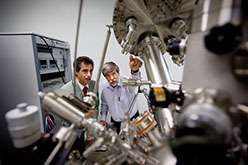Plastic: The new energy source

QUT's research to develop cheap plastic solar cells to charge mobile phones and other electronic devices has been boosted with the installation of one of the most powerful nanotechnology microscopes in the world.
The only one if its kind in Australia, the Zeiss Orion NanoFab enables researchers to examine natural or manmade structures in incredible detail, and will create new insights wherever it is applied.
By increasing the microscope beam current, researchers are able to etch away material to create patterns or structures with features of only a few nanometres. This is a tool that can write lines 100,000 times finer than the text on a printed page. Imagine War and Peace etched on the head of a pin - 200 times over.
QUT nanotechnology expert, Professor Nunzio Motta, said the new microscope complemented QUT's existing tunnelling microscope, the only one of its kind in Queensland, and would cement the university's place at the cutting edge of Australian nanotechnology research.
He said the super microscopes would be used to create new nanostructures which could be used in electronic devices, solar cells, gas sensors and for a range of other uses.
"At the moment plastic solar cells are quite inefficient and researchers around the world are trying to determine how to make the cells efficient and able to be commercialised," Professor Motta said.
"The advantages cheap solar cells would produce would be enormous.
"In the future plastic solar cells could generate enough energy not only to recharge the batteries of laptops and mobiles, but even to obtain power from canopies on parking areas which could be fed back into grids.
"They could even be developed as a clear film on glass windows to produce power."
Professor Motta is currently using the tunnelling microscope to improve plastic solar cells by mixing them with graphene, an atomic-scale honeycomb lattice made of carbon atoms. He has found that adding gold nano-particles traps light and improves efficiency.
"While it's difficult to put a timeframe on the development of efficient plastic solar cells, a five to ten year goal is probably not unrealistic," he said.
Professor Motta said his research team also hoped to create a new class of solar-powered nano-sensors capable of detecting pollution and monitoring the environment in remote areas.
He said nanoscale science was critical to the world's future economy as advances would transform a range of scientific and engineering disciplines.
Professor Motta said QUT was organizing NanoS-E3, an International Workshop and School on nanotechnology at Airlie Beach in September.
Provided by Queensland University of Technology


















